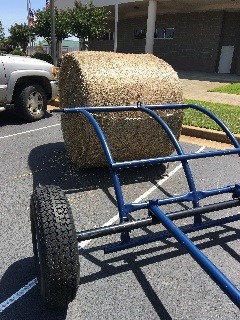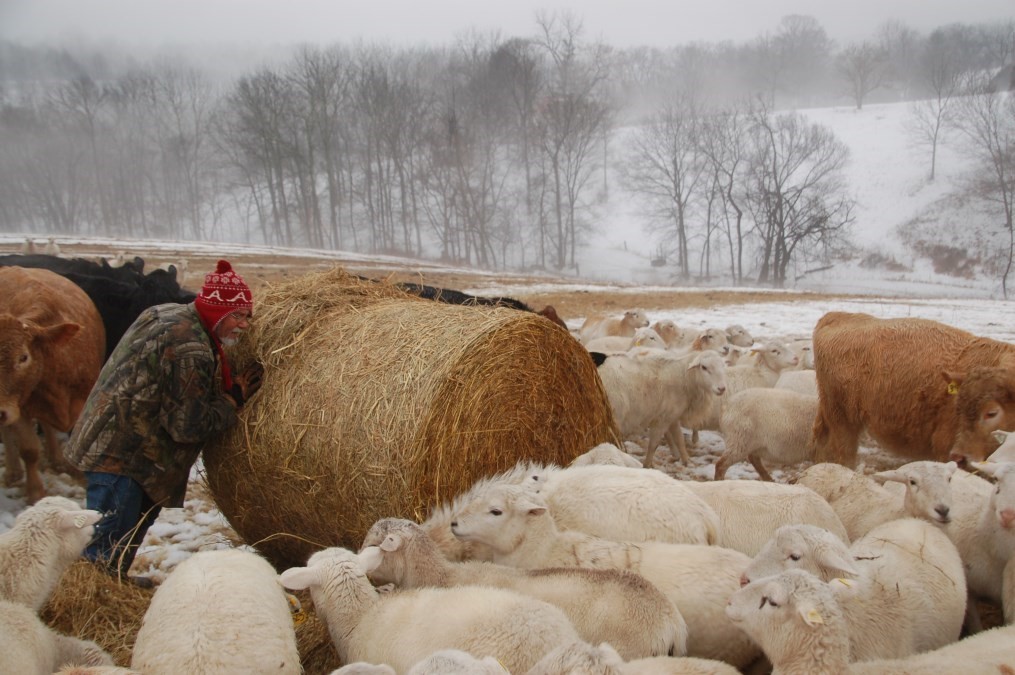
Hay Feeding Strategies

Hay Feeding 101, 201, and 301
Here is where Debbie lets me nerd out about hay feeding. In this post, you’ll find tips for hay feeding in fall, winter, and Spring and why, if the conditions are right, I prefer to feed in the fall and stockpile my grass while it’s growing. I’ll also walk you through how to calculate your hay needs for the winter, but a warning is appropriate here, it’s not for the faint of heart! We’ll also delve into the different types of feeding options. So, let’s go.
The place to start when trying to calculate your hay needs is with plenty of numbers, but if you plan to guess or if you know your needs based on previous years, please feel free to scroll down to the different hay feeding techniques.
Bear with me on this because there are lots of numbers. Each time you do a calculation, ask yourself if this sounds reasonable.
– One animal unit (1,000-pound animal) consumes 30 pounds per day
– An acre inch of good grass weighs 300 pounds per acre inch
– Animals waste 50% of standing forage.
– Five sheep equals one animal unit
– Six goats equals one animal unit
Inventory the number of animals or animal units to feed grass or hay. Since I run multispecies, it’s easiest for me to convert everything to animal units. After the calf reaches 300 pounds, count the calf’s needs in addition to the cow’s needs. The default animal demand is 3% of their body weight. It will vary from 2% to over 3%, but there are losses, so I usually just use 3% for easy calculations. It’s just an estimate, anyway.
So, let’s do an example of round numbers for easy math: 10 cows (@ 1,000 pounds) with young calves and 20 ewes (@ 120 pounds), 12 nanny goats (@ 90 pounds), one bull (@ 2,000 pounds), one ram (@ 200 pounds) and one buck (@ 200 pounds).
Animal units
10 AU cattle, 2 AU sheep, and 2 AU goats plus 2 AU for the bull, .2 AU for a ram, and 0.2 AU for the buck. This brings the total animal units to 16.4; now multiply this by 1,000 pounds to get 16,400 pounds times 0.03 consumed per animal unit equals 492 pounds of grass needed per day, but let’s round up to 500 pounds just to be safe.
Inventory pastures and standing grass and estimated grazing days. Add up all the grazable acres of standing grass you have on the farm. An example would be inches across all fields: 4”, 6”, 8”, 10”, 5”, and 7”, equaling a total of 40”. For purposes of example, let’s assume all the fields are the same size, 5 acres per field for a total of 30 acres.
The average weight of dry grass per acre inch in a productive field with thick grass is 300 pounds. So 40” forage x 300 (pounds per acre inch) x 5 acres = 60,000 pounds of dry matter standing, but only 50% of this will be consumed by livestock due to stomping, laying, defecation, and urination on forage. So, really, we can only count on 30,000 pounds of actual dry matter consumed.
Now, to calculate how long this will last, divide by animal demand of 500 pounds of dry matter per day. Meaning the standing pasture will last 60 days. If the pasture didn’t grow anymore, we would be out of the grass in two months. This time of year, with moisture, grass will grow 20- 40 pounds per acre per day through October and will continue slower growth through early December. So, sixty days x 30 pounds per day x 30 acres = 54,000 pounds grown x 50 % loss = 27,000 pounds predicted to grow again divided by animal demand of 500 pounds per day = 54 additional days of grazing for a total of 114 days, so we predict grazing through mid-December.
Hay will be needed through March, so 3.5 months (let’s call it four months). So, 120 days x 500 pounds needed per day = 60,000 pounds of hay needed, but there are losses with hay, too, so let’s add 20% for losses from handling and feeding. That brings your hay needed to purchase to 72,000 pounds. Hay will keep in the barn with very little loss over time, so it is good insurance.
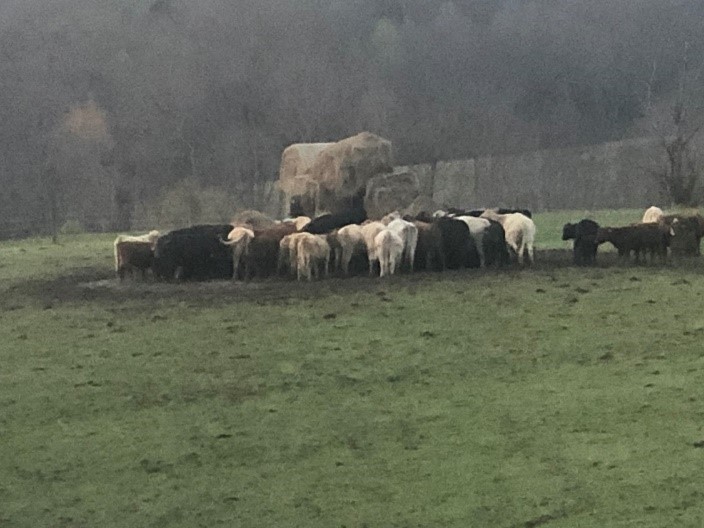
One Location feeding.
If one hay-feeding site is used, choose that site wisely. It should be 300’ or more from drainage ways and other water areas, away from sinks and ditches, and be on a slope of 5% or less. If feeding is done near sensitive areas, it’s potentially an environmental disaster and a contributor to poor water quality and disease. If animals spend their days in mud, their energy needs are increased as much as 2x.
These areas need to be sown in something like bermudagrass or tall fescue to reduce weeds and take advantage of nutrients.
The idea here is to reduce impacts on the pasture, which is understandable but not a good plan for profit. The manure value is $20/1000 lb. roll of hay and the cost of reseeding an acre is less than $50/ac, so it’s ideal to feed hay on your most infertile ground. The manure is worth 10 x more than the cost of reseeding the small area impacted by feeding hay across a pasture.
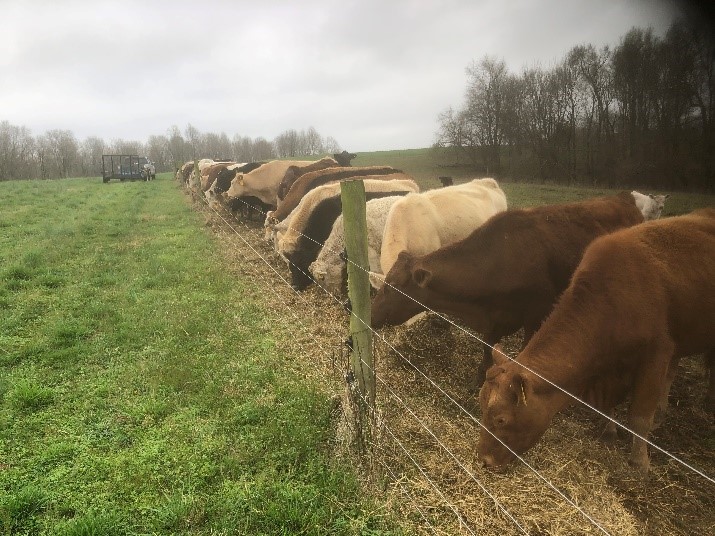
Supplemental hay feeding square bales on a fence line. Flaking them out will allow all stock to get a bite of high-quality hay.
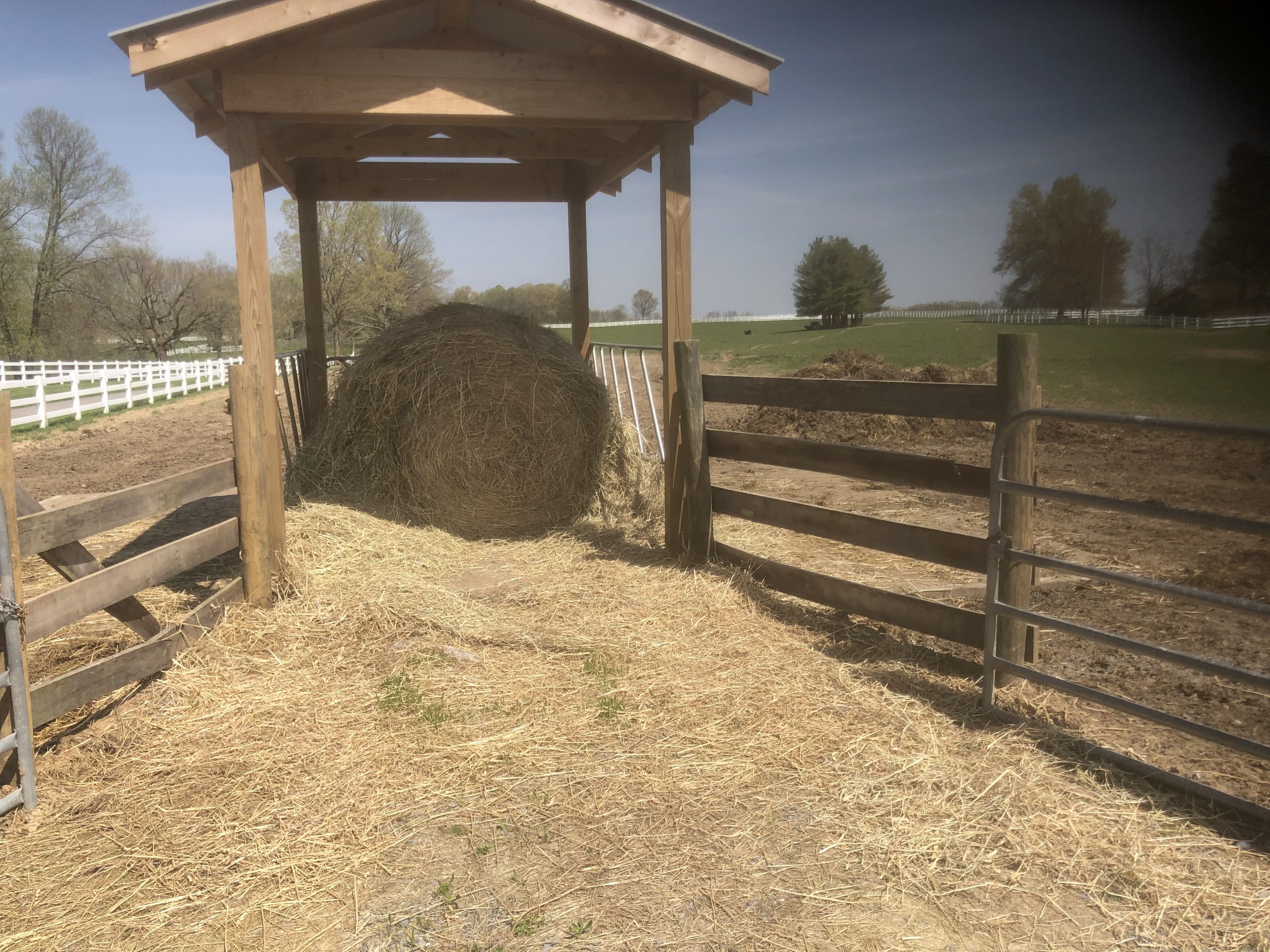
Fenceline feeders are an improvement on one-location feeding because the tractor doesn’t have to enter the field, creating tracks and compacting it. However, it is still a method of one-site feeding, which has some downfalls.
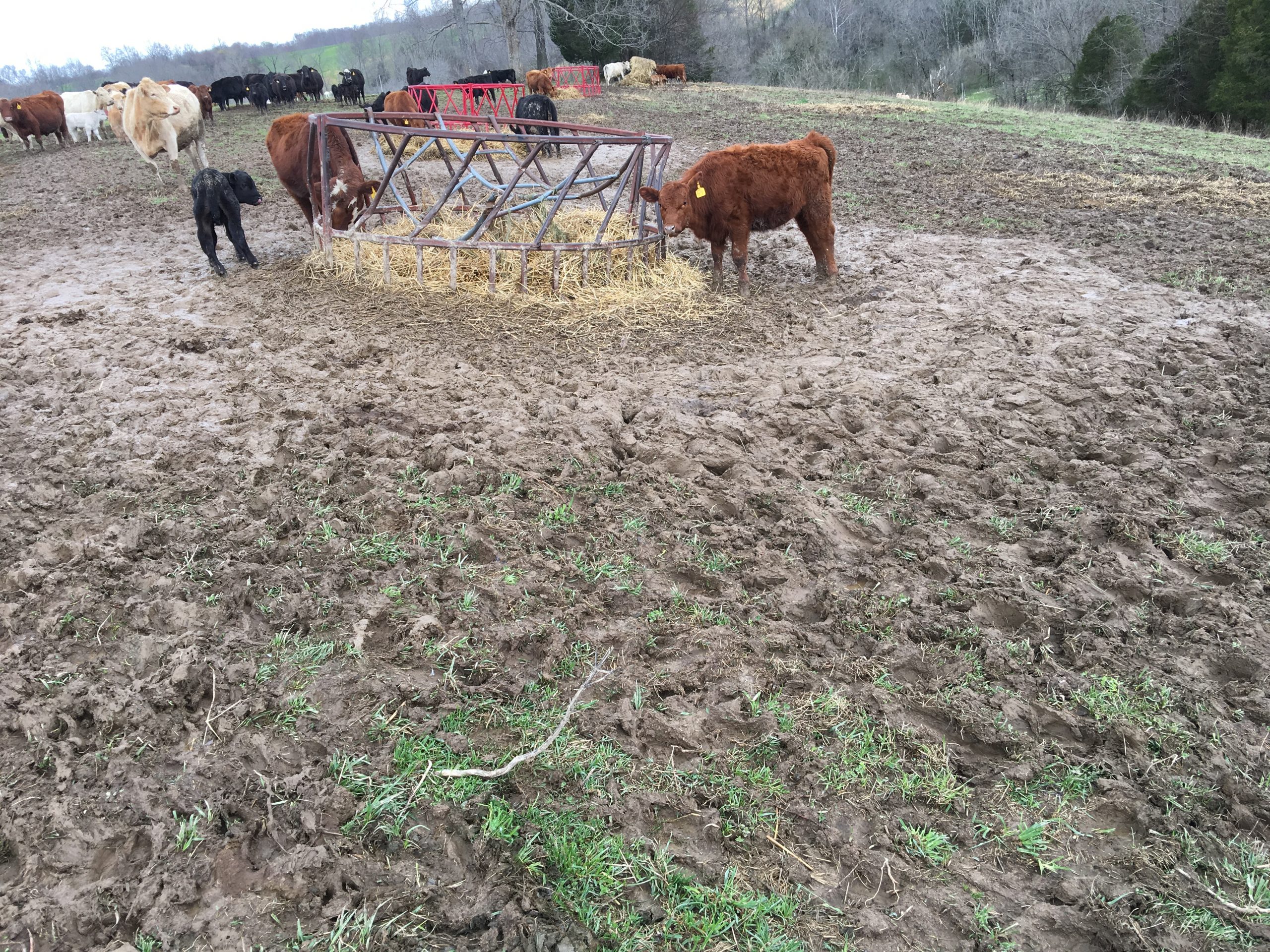
Although this looks bad, with a recovery of 90 or more days in the growing season, it was much better grass and clover than the previous year. Sometimes, in rainy times, I don’t use a hay ring, reducing the mud.
Accumulated waste should be gathered and ideally covered by a roof until it is spread on the land. If you have a pad, concrete is the easiest to scrape. If using a gravel pad, you should leave a couple of inches of manure on the pad to keep from scraping up gravel and spreading it on fields. Since the cost of spreading usually equals the value of the manure, it isn’t a great value at this point, and we call it waste. Since most of the nitrogen comes from the urine, you’ll lose it to leaching if the manure is left in one place.
Fall feeding:
I prefer to feed hay in the fall when I can grow grass. This allows me to feed much less hay. It is possible to grow as much as five times the grass than hay fed in the fall, but there are many variables to consider.
Decent soil fertility and properly managed grazing heights will grow more grass. Fall hay feeding can dramatically improve fields with weed problems and low fertility. Ideally, allow sacrifice areas substantial recovery time before winter, and you’ll see quick spring green-ups.
The minimum recommended grazing height for cool-season grasses, such as tall fescue, is 4” during the growing season. I don’t like to see it taken below 2” in the winter.
Bale Grazing. There are many different ways to do bale grazing. It’s important to place the bales in the field when the soil is dry or frozen and place the bales strategically to accomplish the desired nutrient distribution. The cows will cycle 80 to 90 percent of the hay back onto the pasture as nutrients; therefore, if you want to increase fertility, you may want to place the rolls as close together as 30’ apart, which is equivalent to 24 tons of hay biomass/ac. If you are looking to maintain fertility, place the rolls approximately 80’ apart, which equals about 3.5 tons of hay/ac.
Ideally, stockpiled grass would be available along with hay, which would be rationed with a temporary wire fence like polywire. You would paddock off an estimated amount of hay needed for 3 days or less. Example: 30 cows weighing 1200 pounds x 0.03 (percent of body wt. consumed per day) x 3 days = 3240 pounds. So, provide them access to 3 rolls. If the available grass is substantial, reduce the quantity of hay accordingly. Good grass is typically about 300 lb/acre inch. However, only approximately 50% is consumed. Example: 8” grass x 300 lb/ac. In. x 0.50 (grazing efficiency) = 1200 lb, so reduce hay feeding by about one roll/day for every acre of grazing when available grass is substantial.
Hay can be placed behind a high hot wire, providing calves or other stock the ability to forward-graze to more or better hay.
The biggest advantage to bale grazing is labor savings over unrolling hay.
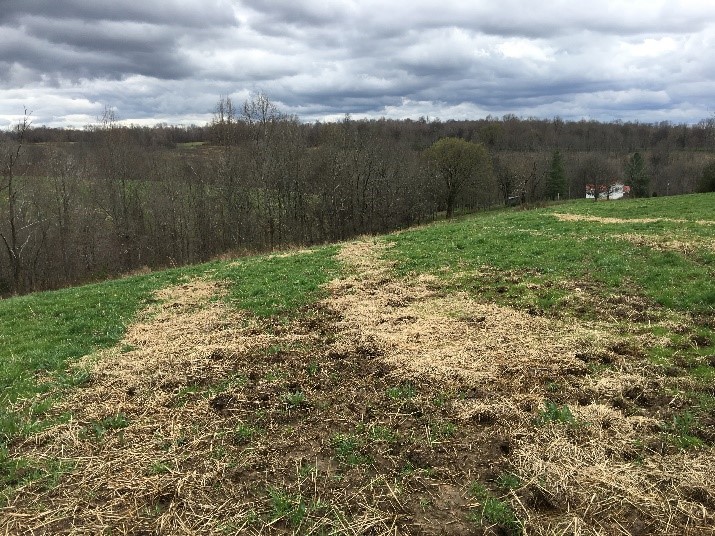
Unrolling hay. I like this method best, but to do it right, it’s labor-intensive. It really should be done once or twice a day, unrolling half of the animals’ needs in the morning and the other half in the afternoon to simulate grazing. They need to clean up most of the hay before feeding again. All hay isn’t equal, so don’t make them clean up junk hay.
One big advantage to unrolling hay is that all animals are on a more equal playing field, with everyone having more access to hay. Hay rings can limit access, and animals at the bottom of the pecking order, like young calves and sheep, won’t have equal access to the hay in a ring. Unrolling hay has great strategic manure placement.
Feeding in rings versus not using rings. This may be controversial, but there’s no doubt that although rings will conserve hay, the mud-out is much worse with a ring than without it. My experience is if you have enough stock to clean up the hay in a day or less, the hay waste is minimal, but if the hay is there for multiple days, a ring is going to be your best bet.
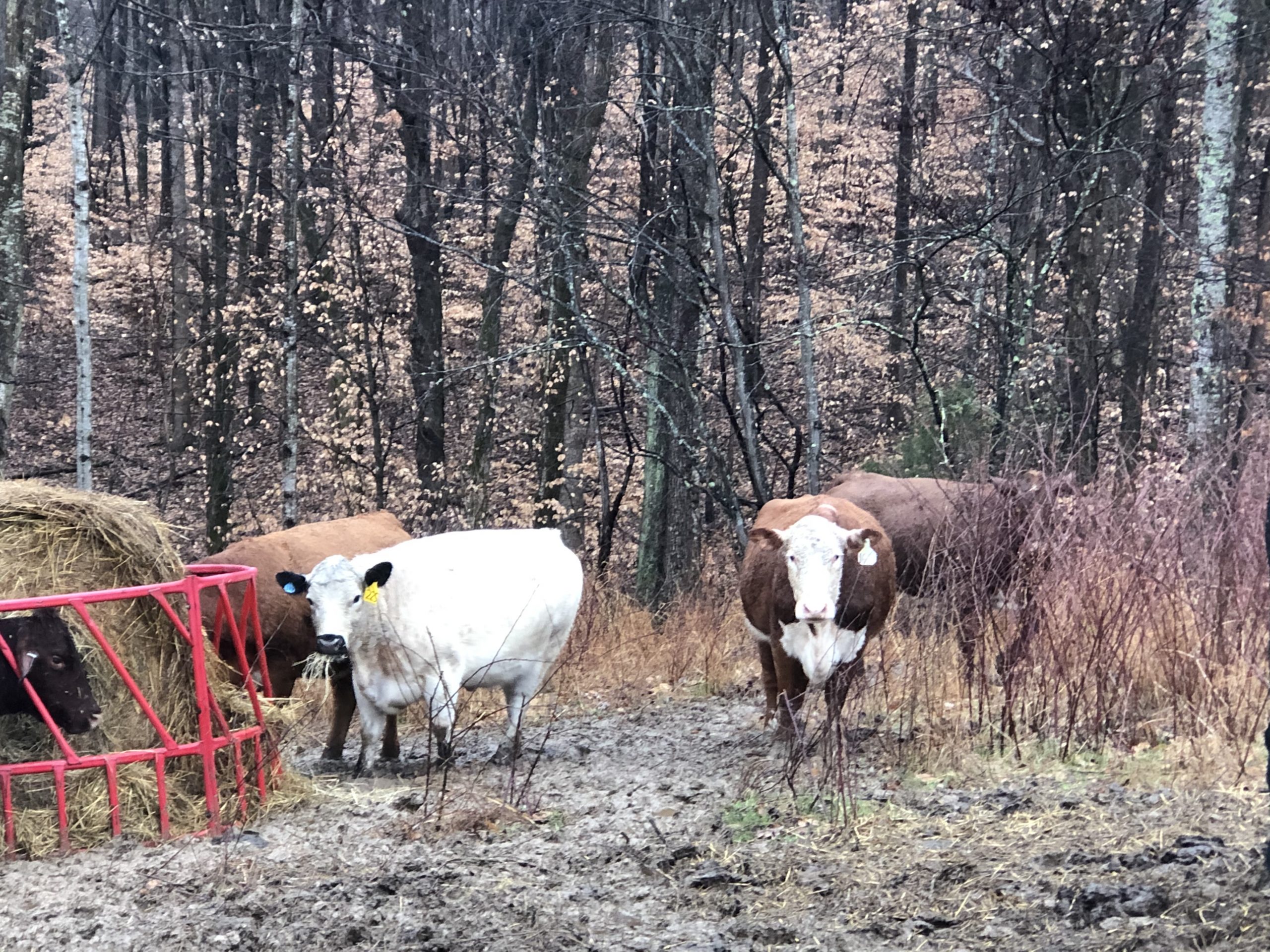
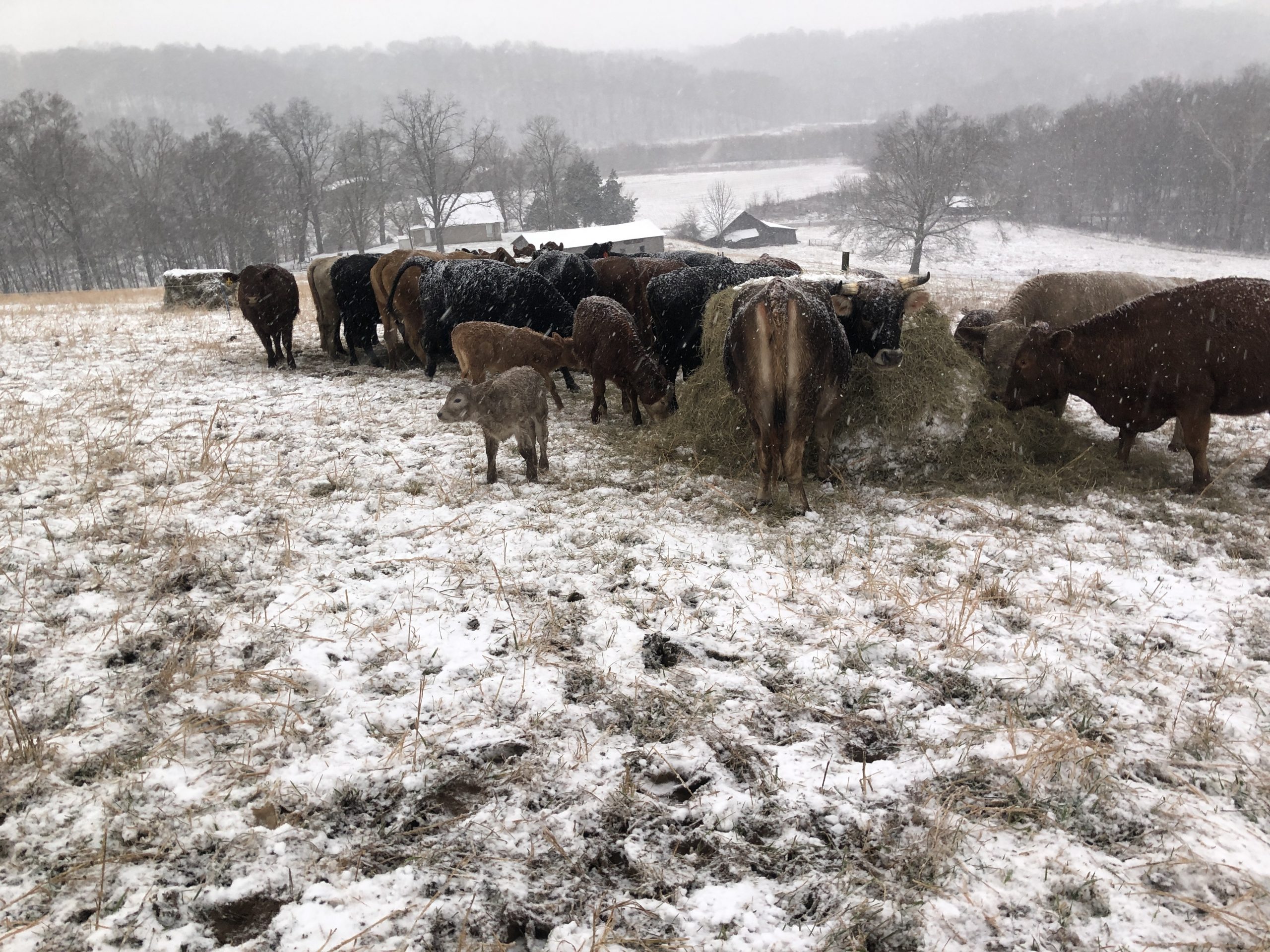
Remember, grazing is half the cost of hay. If you feed 3- 1000 lb rolls a day, and hay cost is $40/roll, every day you graze instead of feeding hay will save you $120 since the nutrients (N-P-K) in those three rolls are worth about $60.
Spring Hay Feeding – Don’t stop too early!
I want to encourage everyone to feed hay a little longer in the spring to let the grass get a good start. Spring grass is washy with high water content and some hay fed along with it helps to slow the rate of passage, improving digestibility. Also, allowing the grass to get a good start gives you a buffer of extra grass through the year. Typically, I will feed hay into early April.
Wishing you the best, if you have questions, concerns, or rebuttals about anything I have presented respond to me at gregbrann5@gmail.com. There are many ways to accomplish regenerative grazing.

